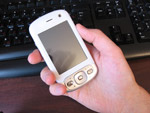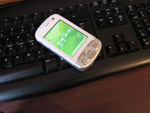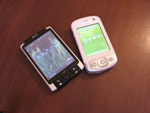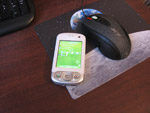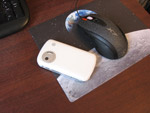|
|
Review of UMTS-communicator HTC P3600 (Trinity)
Live photo of HTC P3600 (Trinity)
Sales package:
- Smartphone
- 1500 mAh battery
- User Guide
- Charger
- CD with software (ActiveSync and Outlook)
- Mini-USB data cable
- Stereo-headset
- Belt pouch

As soon as the HTC Magician platform was released into the wild, other brands launched a bunch of communicators employing it. For them, as well as for HTC itself, the platform proved to be a wild success – offerings running on HTC Magician (Qtek S100, i-Mate Jam) are demanded even these days, over and above there is also an indirect factor suggesting that it was a hugely successful solution, to be more precise, HTC did actually update the platform (Qtek S110, i-Mate Jam Black). The HTC Prophet platform inherited the concept of the series of thumbboard-less communicators, however capped CPU speed and hence decreased performance outweighed its more lightweight price tag (as opposed to its predecessor back then) in the eyes of consumers. This is how come even today users are looking for HTC Magician-based devices, preferring them to a fresher platform.
HTC P3600 codenamed Trinity (HTC’s developers keep on using imagination for new nicknames of their products), basing off the platform bearing the same name, makes more sense when considered as the successor to the HTC Magician. Listing out the improvements in brief, there are 3G support, enhanced camera module, and the OS powered by a new update pack. In light of the new policy the company applies to the carriers and cooperation with other brands, implying gradual shutting-down of these areas, it is almost for sure that Trinity platform won’t see any third-party solutions, saving for Orange SPV M700, and the models pool will remain the same: HTC P3600 for the European market and Dopod D810 – for Asia.
Design and controls
Physically (108x58.2x18.4 mm, weight 150 g) HTC P3600 doesn’t stand out against background of its rivals. While it readily slips into a trousers pocket without causing any discomfort, its dimensions will make all the difference when the P3600 is put in a jacket’s pocket. The best way to carry it, bearing in mind the size and weight – a bag or a back pack. The communicator’s loudspeaker volume also speaks in favor of these two options, yet we will get back to that a bit later in the review.

Coming up with a new form-factor for a keyboard-less communicator is quite a challenging task, as no matter what you think of, its constituents will be a huge display and a navigation block crammed into the candy-bar casing. This is basically the way HTC P3600 looks. The casing has its edges rounded, which makes it a very smooth-and-neat looking device. The Trinity will come in two color schemes – white and black. At that on most web pages, including the vendor’s official site, the white-colored edition is dominating, while Russia is more likely to get only supplies with the black-finished variation. Apart from the base color, there are silver-painted details, which are the bottom part of the casing, playing host to the navigation block, party the sides and the camera mounted on the rear.

Plastic is one of HTC P3600’s most interesting traits – anyone who has first-hand knowledge of Apple-branded solutions, specifically its legendary iPods, will get curious and intrigued right after having a glimpse of the Trinity. Almost the entire casing of the communicator is made of glossy plastic, similar to that utilized by iPod players, but to HTC’s credit be it said, the casing isn’t prone to scratches, and it picks them up not more readily than any other handset or communicator employing standard type of plastic. The white-finished model with its combination of glossy plastic and milky color, no matter how strange it sounds, is not a magnet for fingerprints and smudges either. So, in spite of the fact that many have already come to expect white gadgets with glossy coating to lose their smooth looks (one of the fine examples is iPod 5G), HTC P3600 manages to shine even after several months of usage.
Continuing the story on the communicator’s design, we are ought to mention another quirky thing. If you try to recall the range of communicators available to date, you will definitely figure out that models that would have their design as a highlight are almost non-existent - off the top of my head I can say that only the pink-colored Qtek S200 was an exception, particularly this example will help us to go deep into the core of the situation.
For companies dealing with communicators the very fundamentals of success are power of the platform, functionality of the device and, possibly, ergonomics. In their turn, the users of such solutions, for the most part men, base their choice on these specifications; hence design is left out of work in this case. Thus the manufacturers and consumers have come to a private, and the truth is, logical agreement that communicators’ looks is not subject to change. The release of Qtek S200 Pink turned the market upside-down – not particularly successful platform HTC Prophet got a breath of fresh air. The pink-finished communicators were all the rage back then – make no mistake about that. For the Taiwanese maker, the experience it gets with HTC P3600 is crucial in the sense of learning another way of deviating from the cliched communicator design. The P3600 catches everyone’s eyes with its looks, which is due to the fact that the Trinity is housed in an offbeat casing, uncommon for such devices, that comes in a variety of colors (the milky trim seems more alluring, while the black scheme is a more austere variation).

The fascia of the communicator, apart from the display, houses the navigation block, which is pretty much traditional for HTC, we will say a few words about it below. The top part of the faceplate features the earpiece and forward-facing VGA camera for video calls – the latter feature is still unavailable in Russia, at that the camera cannot be activated for any other purposes. Turning the device around, reveals a camera and a loudspeaker placed in the top left corner – these details are located in a small circle differing from the rest of the casing in color. I can’t really say it is the best idea around, but it does brighten things up for the otherwise bald rear plate. To the right of it is a rubber grommet covering an external antenna slot, at the bottom there are also two tiny ridges enabling you to put the communicator faceup. Generally, the back plate of the Trinity showcases the quality of the plastic use and that is pretty much about it.


The left spine now presents you with a long-anticipated scroll wheel that was used nowhere but on HTC TyTN before. The wheel feels sturdy enough, yet is too sensitive – while managing it, you always have to keep in mind how hard you push it, and if you don’t, you will easily end up making wrong presses time after time. Beneath the wheel is OK button serving for three purposes. While at Today screen it calls up Start menu; while running an application or browsing a menu item the side-mounted OK works in the same way as the main key and allows for going back to Today screen. While reading mail or handling the phonebook this key enables you to go one level back. So on HTC P3600 they have managed to implement full-fledged controls for the core functions (mail, web surfing, applications management) with only two elements – a wheel and a key. And this really counts for something – in most today’s communicators single-handed usability is not the strongest part.
Looking at the right side reveals two buttons, specifically the power key and voice notes shortcut; further down, there is MiniSD memory expansion slot. The slot is covered by a flap made of soft rubber. All three buttons located on the spines can be programmed via the default tools of the operating system.


The top end of the P3600 is free of any kind of sockets, while at the bottom you will find plenty of them, including the proprietary ExtUSB slot, which is here for charging, synchronization via data cable and plugging in headset. While it is compatible with the MiniUSB when it comes to a charger or data cable, any attempt to make use of Motorola’s adapter for linking up the device with 3.5 mm headphones breaks down. We are already tired of writing about this oddity and hoping for a soon shift for the better in this field. So for now let us just repeat our words on this approach, which does make a little sense (in terms of limited compatibility with MiniUSB) and absence of “native” 3.5 mm adapters. Also the bottom rim houses Infrared window, flush-mounted reset key and an eyelet for a carrying strap. Next to the eyelet is the stylus silo, which is quite reliable and this is a very good thing, since the stylus slots into the bottom of the device. To take it out, you will need to hook the stylus with a fingernail, and then put some effort into pushing on it. Size-wise the stylus is almost no different from most of its counterparts, so you will have no hard time getting used to it.


Now on to the navigation block – there are six buttons here in sum and a five-way navigation pad in the centre. HTC’s products always take advantage of having just enough of keys needed for performing basic actions without drawing the stylus. By these we mean OK button placed at the right bottom corner of the bock – using it you can go back to the Today screen from any application or menu. The button brining up Start menu is located on the left in line with OK, and the top row contains two soft-keys. Also the navigation block features three keys for picking/hanging up and the central button respectively. Speaking of the ability to handle HTC-branded communicators single-handedly, we can’t miss the change to explain it by giving an example of other makers’ offerings, for example let’s take Quanta Computer. O2 XDA Atom lacks the key brining you back to Today screen (replaced by a dedicated player key), in Glofiish M700 the bottom row is missing, which leaves it only with pick/hand up buttons and soft-keys onboard, in Orsio n725 the place of the Back key is taken by the Messaging shortcut button, and so on – there are some other examples. HTC has chosen a more consistent way and developed a unified standard for its navigation block that is now mounted on most devices (there may be more keys, but the minimum number is always observed).

All keys are lit in dim white, which doesn’t cause your eyes to strain. For backlighting six buttons this is more than enough. All buttons, expect the central pad, are merged into a single plate that’s slightly raised above the surface. In its turn the central key sticks out this plate a little, making the process of handling the navigation controls a cinch, even though there is no long travel, every press is market with a remarkable click, wrong presses are almost non-existent with the P3600. The only niggle we have concerns the pick/hang up keys – they are too small and poorly placed (between the top and bottom keys of the vertical row), so that occasionally you end up pressing adjacent buttons. For the rest, the navigation pad is really well-made.
Display
Speaking of the display, we will have to use a cliche again, for it is similar to most screens found on the majority of recently-released Windows Mobile-communicators. The matrix sporting a resolution of 320x240 pixels (QVGA) and capable of 65 K colors, measures 2.8” diagonally, which is almost an all-time (at least for now) standard for this type of devices, and I’m sick of writing this, honestly. The viewing angles are quite big – the colors actually do get inversed, but don’t make all the difference.
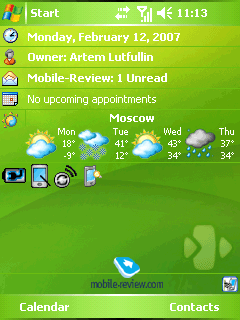
There are 10 backlighting levels available. The display’s behavior in the sun is OK – it gets washed outbut still allows for reading information without any problems. The dimmest level of backlighting fits managing the communicator in the dark best. But overall, the display’s quality is slightly above average owing to splendid viewing angles and very intensive backlighting at the top level.
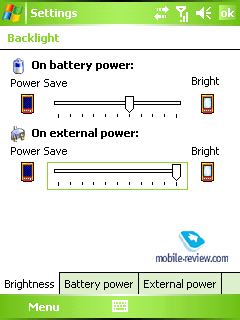
Battery life
The P3600 utilizes a 1500 mAh Li-Ion battery. For HTC’s latest offerings the state of things on power consumption front is pretty much the same, thus the capacity of the Trinity’s battery is used to its fullest. In conditions of Moscow networks at 30-40 minutes of calls a day, 10-15 messages, up to 30 minutes of Web surfing a day, the cell managed to keep the device up and running for 3 full days. By comparison, similar gadgets, at the same usage mode, last 1,5-2 day, so for a communicator the P3600 puts up some big numbers.
The SIM-card mounting isn’t something we have used to, but it is a frequent guest on communicators. The card is placed under the battery in a simple slot, at that to extract it you need to push inward the plate before the SIM-card and then push it out on the opposite side using the stylus. Taking account of the fact that swapping SIM cards is not a frequent occasion for most, we have no gripes with this slot; it is reliable and impossible to break.

Camera
The communicator houses a 2 Mpix camera lacking auto focus and macro mode. The practice of equipping WM-powered offerings with worse camera modules (time after time) is dying now, yet too slow. Quality of snaps taken outdoors is fine, especially if that was a sunny day, but you go indoors and things get considerably worse. We could say much on parameters affecting the quality, but this wouldn’t make much sense – just take a look for yourself.
All recent HTC-branded solutions are characterized by a specific user interface: semitransparent menu laid on the viewfinder mode of the display. Generally speaking, it is quite comfortable but switching between menu items could be simpler. And now a few words about camera interface and settings (names of options and menus are given for the local version of the communicator).. The following resolutions for still image mode are available:
- 2M – 1600x1200 pixels
- 1M – 1280x960 pixels
- L – 640X480 pixels
- M – 320x240 pixels
- S – 160x120 pixels
Picture quality (affects mainly size of an image):
- Super Fine
- Fine
- Normal
- Basic
White balance:
- Auto
- Daylight
- Night
- Incandescent
- Fluorescent
Effects:
- Grayscale
- Sepia
- Cool
- Negative
Values of Contrast, Saturation, Hue, Sharpness, Contrast can be altered as well (adjusted automatically by default). Advanced settings include self-timer, time stamp, shutter sound and some more.
Using “1” key you can easily navigate through the shooting modes and get into video capturing, for example. The device records video in MPEG4, MotionJPEG, H.263 formats with a resolution of CIF (352x288), H (320x240), M (176x144) or S (128x96). All in all the settings for video copy those of still images, the differences include: sound recording (on/off), adjustable clip’s length and size limits. Quality, as well as resolution, of the video clips captured with the P3600 is quite mediocre:
Apart from photo and video modes the S620’s camera has some more to offer – video for MMS, still image for a contact, sport and panoramic modes, which can be activated by pressing “1”. As regards “sport mode” – it’s a sequence of shots (up to 5) taken in rapid succession. While in panoramic mode the device “sticks” together taken snaps on its own. Because of that the final picture looks quite authentic. “Stuck” parts can be spotted only when viewing a picture on a PC screen.
 |
 |
(+)
maximize, 1600x1200 |
(+)
maximize, 1600x1200 |
 |
 |
(+)
maximize, 1600x1200 |
(+)
maximize, 1600x1200 |
 |
 |
(+)
maximize, 1600x1200 |
(+)
maximize, 1600x1200 |
 |
 |
(+)
maximize, 1600x1200 |
(+)
maximize, 1600x1200 |
 |
 |
(+)
maximize, 1600x1200 |
(+)
maximize, 1600x1200 |
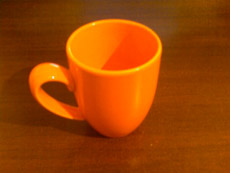 |
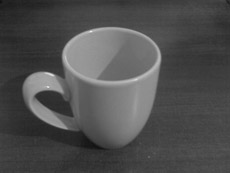 |
(+)
maximize, 1600x1200 |
(+)
maximize, 1600x1200 |
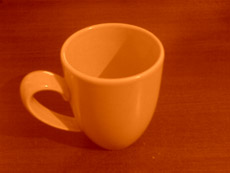 |
 |
(+)
maximize, 1600x1200 |
(+)
maximize, 1600x1200 |
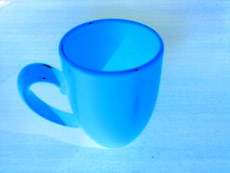 |
|
(+)
maximize, 1600x1200 |
|
 |
 |
(+)
maximize, 1408x480 |
(+)
maximize, 1408x480 |
 |
|
(+)
maximize, 1408x480 |
|
Performance
The communicator is powered by Samsung SC32442A running at 400 MHz. The company has already used this CPU in HTC TyTN, leading to comparable figures in performance between these two models. The user has access to 49.35 Mb of RAM (out of 64 Mb), while volume of manageable flash memory (used for storing user data) makes up 49.10 Mb (out of 128 Mb). Volume of RAM turns out sufficient for almost any case, while size of built-in flash-memory is nothing to worry about thanks to the memory expansion slot.
For HTC itself the new communicator places among the top performers in its range – compared to its rival, O2 XDA Atom, the Trinity pales a bit, having slightly worse results. We should mention, though, that performance put up by either of the two offerings is enough to satisfy any user and cope with any task – be it unconverted video or Skype calls.
The story on the device’s performance kicks off with our traditional benchmark - SPB Benchmark kit. However as the times go by, it is getting less competent, even when Windows Mobile-based devices are put face-to-face. For comparison’s sake:
CPU Index – The index shows the CPU output. The model improves upon the more aged CPU, yet HTC’s communicator stays behind its main competitor - O2 XDA Atom

File System Index – These figures display how fast device’s memory is (read/record/transfer). The File System speed of the P3600 is quite good, if we turn a blind eye to Orsio n725 (whose result is so incredibly thanks to the optimization its FS has undergone).

We also carried out a video test in The Core Pocket Media Player (TCPMP) and acquired the following results. The performance revolves mainly around graphics accelerators and Wireless MMX kit, implemented into the latest Intel XScale CPU. Rate about 100% means that normally films are played back with no dropped frames, yet dynamic scenes might fall flat in maintaining perfect rating.

As you see, HTC P3600 handles video in a convenient fashion, and allows for watching movies without having to convert them.
Connectivity
The cellular module found on the P3600 supports both GSM (GSM 850/900/1800/1900) and 3G (HSDPA/UMTS). Also the communicator has support for EDGE.
The sole interface socket for HTC’s devices is standard – ExtUSB, which serves for charging purposes, as well as USB connectivity and headset connection. The socket itself has already been spoken of in our reviews numerous times, so the only thing we have to add is hope that the company will realize the dire need in a 3.5 mm adapter sometime soon.
For handling wireless connectivity options you are free to make use of either the default OS tools, or HTC’s own utility HTC – CommManager.
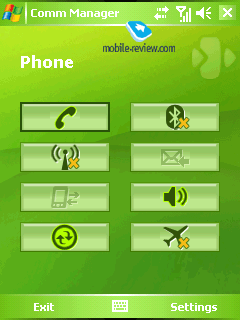
Bluetooth 2.0 without EDR, but boasts considerably increased number of supported profiles, comparable with HTC Herald. Bluetooth module is managed by standard Microsoft’s drivers. Let us see what BT here can do and for what purpose.
- Serial Port Profile (SPP). Emulates COM-connection of devices. Used mainly for synchronization with desktop PC, coupling external Bluetooth-gadgets, like Bluetooth GPS-receiver.
- Object Push Profile (OPP). A basic profile for sending "objects" such as pictures, virtual business cards, or appointment details.
- File Transfer Profile (FTP). Provides access to the file system on another device. This includes support for getting folder listings, changing to different folders, getting files, putting files and deleting files. For the first time this profile is implemented on HTC devices basing off Microsoft’s stack.
- Hands-Free Profile (HFP). Connection of Bluetooth-headset and handsfree device.
- Human Interface Device Profile (HID). Connection of Bluetooth-keyboard.
- Advanced Audio Distribution Profile (A2DP). Sound transfer via Bluetooth.
- Audio Video Remote Control Profile (AVRCP). Music playback management via wireless headset.
- Personal Area Network Profile (PAN). Network connection via Bluetooth, use for connection of a desktop PC to Internet through the communicator, replaces Dual-Up Networking profile.
- SIM Access Profile (SAP). Allows connecting to a SIM card in a phone with Bluetooth, so the car phone itself doesn't require a separate SIM card
Wi-Fi version 802.11 b/g. The WM 5.0 upgraded with AKU 3.0 features enhanced setup of Wi-Fi and a stand-alone Wi-Fi-manager (look up in the dedicated AKU 3.3 review at out site). Everything works like a well-oiled machine; setting up Wi-Fi is everything but a hassle. To rate Wi-Fi module found on the P3600 we used the simplest way possible – through a couple of Skype calls.
Software
The communicator runs Windows Mobile 5.0 with installed AKU 3.0 service pack. You can get more information on its standard capabilities in corresponding reviews at our portal. Now we are taking a closer look at the P3600’s extras.
Review of Windows Mobile 5.0 for Smartphone>>>
Review of Windows Mobile 5.0 AKU 3.0>>>
Adobe Reader LE is the most widespread program for viewing PDF documents, and this is its mobile edition. Much like its elder brother, the applications never seems to be in a hurry. Loading a page takes about 10-15 seconds, should the document contain a considerable number of schemes and pictures each page will load for half a minute or even longer. It should be noted that for small files, the viewing capabilities, this application provides, are more than sufficient.
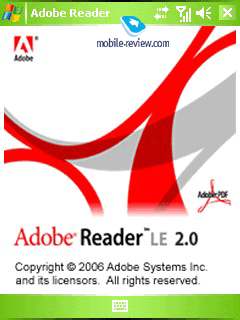 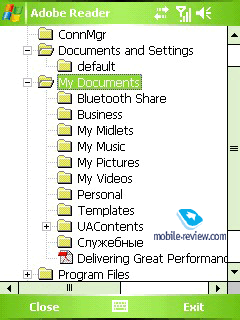
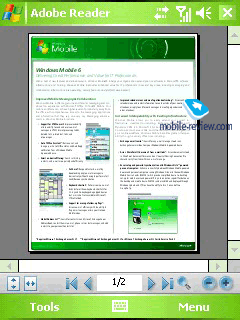 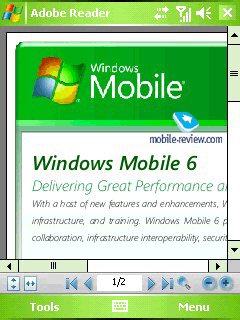
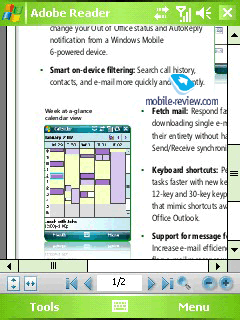
Java - emulator for applications written on Java. Its capabilities are very limited; in light of this fact 3D Java is not supported. In most cases support for Java-powered applications is not relevant on smartphones and communicators, today there are a tons of programs for Windows Mobile. Some users make an exception for OperaMini as this app is simply the winner in save-my-traffic contest. Another example - for Java-games addicts that need such emulator badly. However the regular emulator does not support additional libraries used for creation of Java applications for Nokia-, Motorola-branded and some other handsets. Hence nobody guarantees that these applications will launch and operate properly.
Zip. HTC’s very own utility for handling archived files – you can either extract data from an archive, or add new to an already existing compressed file, as well as precisely adjust parameters of compressions.
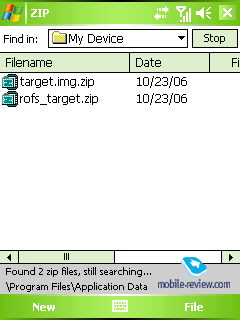 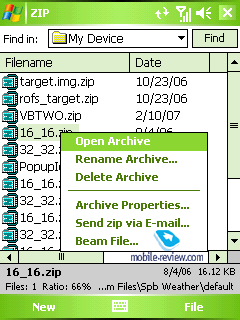
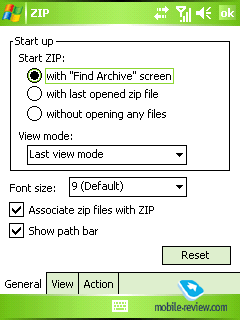
The state of things with extra software for HTC-branded proposals doesn’t show sings of improving – the company delivers its offerings only with the minimum of applications onboard.
Conclusion
Reception quality was never an issue with the P3600, which is what have come to expect from all up-to-date devices. The silent alert is average strength-wise, and occasionally you might end up missing it, and as for the sound volume… in this sense HTC P3600, seemingly, is the top of the heap, and if not, then is definitely closing in on this position. At full blast the loudspeaker cannot cope with the power coming through it, starts creaking, but it’s because of exceedingly high volume for a mobile device rather than mediocre speaker quality. Missing a call when the Trinity is turned at full blast is only possible when you are listening to music in noise cancelling headphones. The earpiece proves average volume level, meaning that while in underground or a busy street, you might now hear what is said on the other end.
The model arrives in the Russian market approximately in the beginning of Q3 in black, even though these days you can find white-finished versions of the P3600 retailed for 750 USD or so. Despite the superfluous add-on in the form of UMTS support (not relevant in Russia), the device will barely have serious competition. Introducing the new keyboard-less communicator since the release of the S100/S110, HTC has come up with an offering that has got real claims to the leadership on the market. And there are many things speaking in favor of these intentions – adequately austere design (black casing for Russia), high performance, HTC brand with its traditional superb build quality. The last point is especially important in the light of fact that, for example, i-Mate and Glofiish probably can deliver a number of rivals, but their quality, specifically the build quality, will prove to be far inferior. Nevertheless we will shed some more light on this issue in one of the impending reviews of Glofiish (E-Ten) branded communicators.
For HTC, the Trinity is a sort of another experiment, this time around in the design department. Listing the model’s rivals, we can’t overlook Quanta Computer platform, which O2 XDA Atom was built on, and later on - Orsio n725 and HP iPAQ 68 Series. HTC wins owing to brand recognition (being known among people keen on such devices), fetching looks, presence of scroll wheel and ability to manage the communicator with one hand without drawing the stylus. A big plus is the build quality as well (Quanta Computer has still some way to go here), but the consumer might miss this detail, due to its being inconspicuous on a cursory examination of the devices.
Specifications:
- Type: Windows Mobile-based communicator
- Form-factor: candy-bar
- Rivals: O2 XDA Atom, HP iPAQ 68 series
- Materials used: glossy plastic
- Operating system: Windows Mobile 5.0 Pocket PC Phone Edition AKU 3.2
- GSM Quad-band 850/900/1800/1900 MHz, EDGE/GPRS class B, Multi-slot standard class 10 UMTS/ HSDPA
- CPU: Samsung SC32442A 400 MHz
- RAM: 64 Mb (49.35 Mb available to user)
- ROM: 49.10 Mb for storing user data and applications
- Connectivity: MiniSD, Bluetooth 2.0, USB for charging/synchronization, Wi-Fi (IEEE802.11b/g), IrDA
- Display: TFT 2.8” (58x44 mm – active zone) with a resolution of QVGA (320x240 pixels), 65 K colors, 10 levels of backlighting
- Battery: detachable 1500 mAh
- Dimensions: 108x58.2x18.4 mm
- Weight: 150 g.
Artem Lutfullin (artem.lutfullin@mobile-review.com)
Translated by Oleg Kononosov (oleg.kononosov@mobile-review.com)
Published — 26 February 2007
Have something to add?! Write us... eldar@mobile-review.com
|
News:
[ 31-07 16:21 ]Sir Jony Ive: Apple Isn't In It For The Money
[ 31-07 13:34 ]Video: Nokia Designer Interviews
[ 31-07 13:10 ]RIM To Layoff 3,000 More Employees
[ 30-07 20:59 ]Video: iPhone 5 Housing Shown Off
[ 30-07 19:12 ]Android Fortunes Decline In U.S.
[ 25-07 16:18 ]Why Apple Is Suing Samsung?
[ 25-07 15:53 ]A Few Choice Quotes About Apple ... By Samsung
[ 23-07 20:25 ]Russian iOS Hacker Calls It A Day
[ 23-07 17:40 ]Video: It's Still Not Out, But Galaxy Note 10.1 Gets An Ad
[ 19-07 19:10 ]Another Loss For Nokia: $1 Billion Down In Q2
[ 19-07 17:22 ]British Judge Orders Apple To Run Ads Saying Samsung Did Not Copy Them
[ 19-07 16:57 ]iPhone 5 To Feature Nano-SIM Cards
[ 18-07 14:20 ]What The iPad Could Have Looked Like ...
[ 18-07 13:25 ]App Store Hack Is Still Going Strong Despite Apple's Best Efforts
[ 13-07 12:34 ]Infographic: The (Hypothetical) Sale Of RIM
[ 13-07 11:10 ]Video: iPhone Hacker Makes In-App Purchases Free
[ 12-07 19:50 ]iPhone 5 Images Leak Again
[ 12-07 17:51 ]Android Takes 50%+ Of U.S. And Europe
[ 11-07 16:02 ]Apple Involved In 60% Of Patent Suits
[ 11-07 13:14 ]Video: Kindle Fire Gets A Jelly Bean
Subscribe
|
